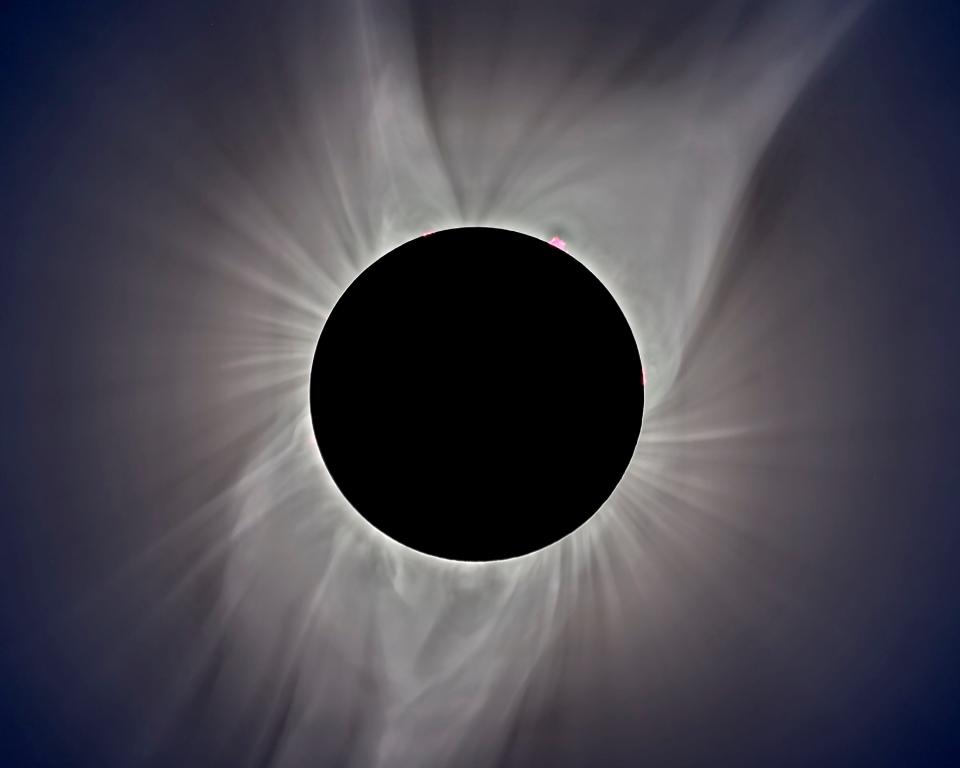The total solar eclipse is Monday: Where will clouds, rain ruin the sky spectacle?
We're almost there.
In just two days, for just the second time in seven years, day will suddenly become night for a few brief, wondrous minutes as the orbiting moon blocks the sun's light along a southwest-to-northeast path across the continent.
Meteorologists continue to refine their forecasts for the total solar eclipse, and now have a pretty good idea of where the spectacle will be most (and least) visible.
Here's the latest forecast:

Where will the solar eclipse be visible?
Federal forecasters said Saturday afternoon that the best chances for clear viewing of the total eclipse are in northern New England. There is also a possibility of clear viewing from northern Arkansas to central Indiana, the National Weather Service said, "but this is the area of greatest uncertainty due to potential high clouds."
"Clouds can break for some sunshine, just in time for the afternoon viewing from Chicago to Cleveland. A narrow region of good viewing is expected to open up for cities like Kansas City, Indianapolis, and St. Louis," AccuWeather lead long-range forecaster Paul Pastelok said.
The weather service also warned of possible (20% to 30% chance) rain showers during totality in Texas, Oklahoma, southern Arkansas, Ohio, northwestern Pennsylvania and western New York.
Outside the path of totality, which stretches from Texas to Maine, "the best locations for viewing should be across the Southwest, out of the mountains," Pastelok said. Other good spots include "California, again, out of the mountains, New England, and parts of the mid-Atlantic and Southeast."
"Cities like Los Angeles, El Paso, New York City, Boston and Raleigh should all have nice views of the eclipse from start to finish," he added.
Here is the updated cloud cover forecast for Monday afternoon during the total solar eclipse. The best chances for clear viewing remain in northern New England and from southern Missouri to central Indiana. There is still uncertainty, so continue to check for forecast updates! pic.twitter.com/n5fXJwU53p
— NWS Weather Prediction Center (@NWSWPC) April 5, 2024
Where will it be cloudy?
Unfortunately for folks in the path of totality, clouds may impede viewing "from Texas into southern Arkansas, and across Ohio, northwest Pennsylvania, and New York," the weather service said.
Elsewhere, for the partial eclipse, AccuWeather long-range expert Joe Lundberg added that "other areas with poor viewing conditions will be from Wisconsin westward through South Dakota and Nebraska to Washington and Oregon."
What time is the solar eclipse?
The eclipse will begin in Texas at 1:27 p.m. CDT and end in Maine at 3:35 p.m. EDT, but the exact time of the eclipse varies by where you are in its path. You can search by zip code to find the exact time for your location.
What is the path of totality?
The path of totality is the area where people on Earth can see the moon completely cover the sun as the moon's shadow falls upon them. Space.com describes it as "the cone-shaped inner (umbral) shadow of the moon projected onto the Earth's surface."
To view all of the stages of a total solar eclipse, you must watch it from somewhere along that path of totality, NASA said. Viewers outside this narrow, roughly 115-mile wide path will only see a partial eclipse of the sun.
You probably don't have to worry about your dogs and cats during the eclipse
Don't worry, your dog and/or cat will likely be oblivious to the eclipse, according to Pasco, a science education company.
"It is unlikely that dogs and cats will react to solar eclipses, as they typically do not have a strong biological or behavioral response to changes in light or natural phenomena like eclipses," Pasco reports.
Just in case, Pasco recommends you keep your pets inside during the eclipse and distract them with toys or treats. Same thing works for people if necessary.
Eclipse boosts travel as Americans chase rare celestial event
The upcoming eclipse is proving to be a good omen for travel firms, as some parts of the United States that fall in the "path of totality" see unprecedented demand for lodging from eager Americans waiting to catch a glimpse of the celestial event.
Airbnb listings along the U.S. path of totality, or the narrow strip stretching from Texas to Maine from where people will be able to view the sun's corona, have seen occupancy levels skyrocket to nearly 90%, the vacation rental firm said.
Occupancy for all active rental listings across the path in the United States, Canada and Mexico was at 92.4% for the night of April 7, up sharply from about 30% a few days prior, according to travel data firm AirDNA.
"It is a nice bump in demand in a relatively slow period of the year. Typically April isn't a high point for short-term rental demand," said Jamie Lane, chief economist at AirDNA.
Beware of potential storms during eclipse travel
Sunday and early Monday, severe thunderstorms bringing hail, strong wind and possibly a tornado could disrupt travel from the western Plains to the Midwest, Pastelok of AccuWeather said. Travel could also be impacted due to visibility with winds kicking up dust and creating a fire risk.
Meanwhile, people driving from the Rockies to the path of totality could face slick roads and wintry conditions, according to AccuWeather.
After the eclipse on Monday evening and Tuesday, federal forecasters warn of a high chance of thunderstorms in parts of the Southern Plains and lower Mississippi Valley. Flash flooding is also possible, "which could lead to hazardous travel after the eclipse," the weather service said.
Contributing: Reuters
This article originally appeared on USA TODAY: Solar eclipse 2024: Here's the latest forecast for stormy skies.

